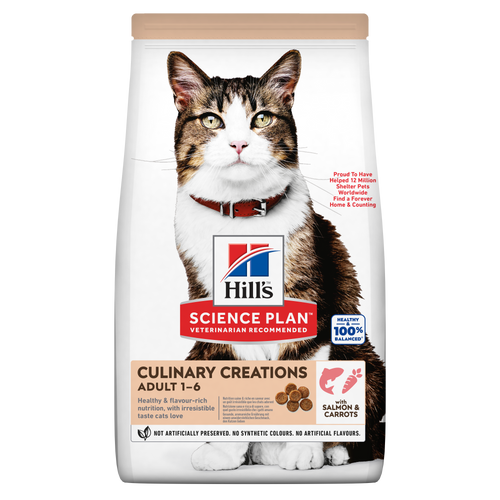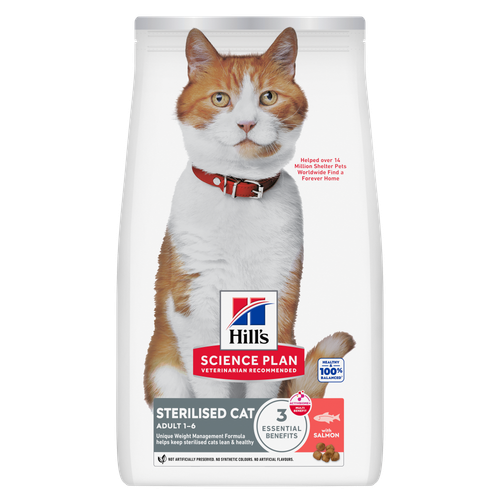
-
Find the right food for your petTake this quiz to see which food may be the best for your furry friend.Find the right food for your petTake this quiz to see which food may be the best for your furry friend.Featured products
 Perfect Digestion Large Breed Puppy Food
Perfect Digestion Large Breed Puppy FoodPrecisely balanced nutrition with Hill's ActivBiome+ prebiotic blend actively contributes to supporting digestive health and overall wellbeing to help your pet feel their best
Shop Now Large Breed Adult Dog Food
Large Breed Adult Dog FoodHill's Science Plan Large Breed Adult Dog Food with Lamb & Rice is a complete pet food, specially formulated with ActivBiome+ Multi-Benefit Technology.
This food is specifically designed to fuel the energy needs of large breed dogs during the prime of their life.Shop Now Adult Light Dog Food
Adult Light Dog FoodHill's Science Plan Light Adult Wet Dog Food is a complete premium pet food for adult dogs that tend to gain weight easily. This deliciously smooth loaf is formulated to deliver the appropriate amount of energy to support weight maintenance in adult dogs.
Shop NowFeatured products CULINARY CREATIONS ADULT CAT FOOD
CULINARY CREATIONS ADULT CAT FOODHill's Science Plan CULINARY CREATIONS Adult cat food with Salmon & Carrots was formulated to provide a great-tasting experience to cats. Its delicious flavour and texture are combine with essential nutrients to support cats' optimal health during the prime time of their life. Specially formulated with high-quality salmon protein, essential taurine for heart health & balanced minerals to support kidneys & bladder.
Shop Now Sterilised Adult Cat Food
Sterilised Adult Cat FoodHill's Science Plan Adult Sterilised Cat Dry Food with Salmon is specially formulated with ActivBiome+ Multi-Benefit Technology. It is a precisely balanced nutrition, tailored to meet the needs of sterilised cats, to help keep sthem lean & healthy.
Shop Now Adult Cat Food
Adult Cat FoodHill's Science Plan Adult Cat Food with Chicken is a complete pet food, specially formulated with ActivBiome+ Multi-Benefit Technology.
This food is specially formulated to fuel the energy needs of cats during the prime of their life.Shop Now -
Dog
- Dog Tips & Articles
-
Health Category
- Weight
- Food & Environmental Sensitivities
- Urinary
- Digestive
- Joint
- Kidney
-
Life Stage
- Puppy Nutrition
- Adult Nutrition
- Senior Nutrition
Cat- Cat Tips & Articles
-
Health Category
- Weight
- Skin & Food Sensitivities
- Urinary
- Digestive
- Kidney
-
Life Stage
- Kitten Nutrition
- Adult Nutrition
Featured articles Pet Nutrition: What Makes "Healthy" Pet Food Healthy? | Hill's Pet
Pet Nutrition: What Makes "Healthy" Pet Food Healthy? | Hill's PetIn people, the right diet is very important. If you are eating the wrong way for your metabolism, activity level, age and lifestyle you could end up with health issues.
Read More Microchipping: The Facts | Hill's Pet
Microchipping: The Facts | Hill's PetThe government has announced that as of April 2016, all dogs in the UK must be microchipped by law.
Read More The Incredible Science Behind Your Pet's Microbiome
The Incredible Science Behind Your Pet's MicrobiomeLearn what your pet's microbiome is, how it contributes to your pet's gut and overall health, and why nutrition is important in maintaining healthy microbiomes.
Read More -


As senior cats slow down, they may walk a little slower, jump more gingerly and play a little less. While this is ordinary behavior for mature cats, the shift may worry pet parents. One way to ensure your pet stays spry is to encourage cat exercises to keep her brain and body active and limber. That little kitten you welcomed home years ago is now an older lady, and it's up to you to advocate for her mental and physical health.
Since cats don't have gym memberships, they'll rely on you to guide them on an exercise journey. Want to know the easiest way to get your pet active? Schedule time to play every single day. Cats are independent creatures, and some may scoff at the idea of working out, especially if they are older and arthritic. However, by tricking a senior cat into playing with you, she'll get the daily activity she needs in quick spurts around the home.
Invest in Playtime
There are many smart tools that can help your mature cat exercise more. These gadgets range from small to big and cheap to expensive, so start small, as your cat may like some and not engage with others. A quick trip to the pet store will give you endless options, so be sure to choose toys and tools that are age appropriate. Vetstreet offers a toy guideline for senior cats to help pet parents identify ideal toys for their elder furry friend.
Small toys and tools your cat may enjoy
- A wand or teaser with feathers that your cat can chase
- Catnip toys
- Puzzle toys that dispense treats
Large toys and tools your cat may enjoy
- A cat climber or condo
- Scratching posts
- A cat wheel (yes, just like a hamster wheel!)


Tasty Tips
Cat Exercise for Free
Cats love climbing, but senior cats who may experience arthritis will eventually have trouble climbing if it's not practiced regularly. Move around your furniture around so your cat is encouraged to jump from the floor to a footstool to the couch before perching on the top of it for her afternoon nap. If you already have a cat condo, persuade your cat to continue using it by hiding healthy cat treats on different levels so she has to jump to enjoy her snack. If you don't own a cat tree, it may be a good idea to invest in a tree or similar type of perch your cat can climb.
Do you happen to have any leftover catnip at home—maybe from a broken or torn old toy? Stuff an old sock with it. You'll get bonus points if you sew a string onto the sock so you can pull the catnip along the floor from a safe distance, making your cat chase it as you go.
Take a look around your house to see what you already own that your cat would love playing with. Have some old fabric you can sew into a ball? Your cat will swat and chase it all over your home. It is best to avoid yarn though, as the strings can be swallowed or get caught around her body causing safety issues. What about empty paper bags or cardboard boxes? Scratch the back of a bag or box and your cat will pounce on her "prey." Find a stick and some string to make a wand or a "fishing pole" to tease your cat. She'll swat and jump to catch whatever you put on the end of the string.
If your cat loves lazy afternoons watching nature from the warmth of a windowsill, install a bird feeder right outside the window. Like television for cats, a bird feeder will bring new (and tempting) creatures into your cat's line of sight. She'll jump up for a view of the hungry birds that are happy to entertain your kitty in exchange for a meal.
Do you have more than one cat? Multiple cats may be more likely to play with each other than one cat would be to start solo play time. Break out the toys and one may encourage the other to get moving.
Brain Games
Senior cats need to exercise their brain too. One way to keep your cat's brain as sharp as a kitten's is by playing food games with her. First, hide mini meals throughout your house in place of a large mid-day meal. Encourage your cat to find them, strategically positioned in low to high spots so your cat will need to work for the meals. Toy treat dispensers are another option to keep your cat using her brain while being rewarded with food. These toys require your cat to complete a puzzle or activity before the treat is released. Just always remember to keep the extra food or treats in proportions so that she is getting the optimum nutrition.
Choose Nourishing Food
Nutrition plays a valuable role in keeping senior cats active and healthy. Before making any changes to your cat's food, consult with your veterinarian. Make sure the meals and treats you're feeding your cat are suited to meet her physical and mental needs. According to the journal Topics in Companion Animal Medicine, maturing cats benefit from "food supplemented with antioxidants, fatty acids, and a prebiotic source."
If you're unsure if your cat is ready for a mature or senior cat food, check out this helpful cat aging tool—it helps you compare your cat's age to human years to get a better sense of where she is at in her lifestage. You can also get helpful facts on the signs of aging to discuss with your veterinarian. Upon talking to your vet, ask if feeding your cat Hill's Science Plan Youthful Vitality cat food is right for your cat. Youthful Vitality is specially formulated with aging cats' needs in mind, to help support your cat's ongoing vitality through increased activity, interaction and mobility.
If your cat enjoys toy puzzles, you'll need to store some extra treats in your home. You can make your own homemade healthy cat treats using Science Plan pet food.
One final tip–don't wait too long before implementing these cat exercises into your pet's everyday life. The sooner your young kitten begins a lifetime of activity, the happier and healthier she'll be for years to come.


Erin Ollila believes in the power of words and how a message can inform—and even transform—its intended audience. Her writing can be found all over the internet and in print, and includes interviews, ghostwriting, blog posts, and creative nonfiction. Erin is a geek for SEO and all things social media. She graduated from Fairfield University with an M.F.A. in Creative Writing. Reach out to her on Twitter @ReinventingErin or learn more about her at http://erinollila.com.
Related products

Hill's Science Plan Adult Sterilised Cat Dry Food with Salmon is specially formulated with ActivBiome+ Multi-Benefit Technology. It is a precisely balanced nutrition, tailored to meet the needs of sterilised cats, to help keep sthem lean & healthy.

Hill's Science Plan Adult Cat Food with Chicken is a complete pet food, specially formulated with ActivBiome+ Multi-Benefit Technology.
This food is specially formulated to fuel the energy needs of cats during the prime of their life.

Hill's Science Plan CULINARY CREATIONS Adult cat food with Salmon & Carrots was formulated to provide a great-tasting experience to cats. Its delicious flavour and texture are combine with essential nutrients to support cats' optimal health during the prime time of their life. Specially formulated with high-quality salmon protein, essential taurine for heart health & balanced minerals to support kidneys & bladder.

Hill's Science Plan Mature Adult Cat Food with Chicken is a complete pet food, specially formulated with ActivBiome+ Multi-Benefit Technology.
This food supports graceful aging in cats, providing a synergistic ingredient blend to help support energy & activity levels.
Related articles

Learn how your cat's poo can be a good indicator of her overall health, including how to spot unhealthy or abnormal cat poop and what it might mean.

Understand common skin issues in cats and how to manage them effectively. Learn signs and prevention, and get care tips. Find out more at Hill's Pet.

Cats with sensitive skin have special needs and even healthy cats can sometimes develop poor skin health. Learn more about sensitive skin symptoms in your cat, what you can do to help your pet feel more comfortable and get recommendations on sensitive skin cat food.

Learn about the causes of cat dermatitis, how to spot the symptoms and the best treatment options. Visit Hill's Pet for detailed guidance and tips.

Put your cat on a diet without them knowing
Our low calorie formula helps you control your cat's weight. It's packed with high-quality protein for building lean muscles, and made with purposeful ingredients for a flavourful, nutritious meal. Clinically proven antioxidants, Vitamin C+E, help promote a healthy immune system.
Put your cat on a diet without them knowing
Our low calorie formula helps you control your cat's weight. It's packed with high-quality protein for building lean muscles, and made with purposeful ingredients for a flavourful, nutritious meal. Clinically proven antioxidants, Vitamin C+E, help promote a healthy immune system.

